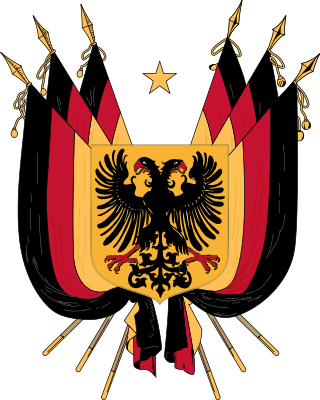Related Research Articles

Austria-Hungary, often referred to as the Austro-Hungarian Empire, the Dual Monarchy, or Austria, was a constitutional monarchy and great power in Central Europe between 1867 and 1918. It was formed with the Austro-Hungarian Compromise of 1867 in the aftermath of the Austro-Prussian War and was dissolved shortly after its defeat in the First World War.

Franz Joseph I or Francis Joseph I was Emperor of Austria, King of Hungary, and the other states of the Habsburg monarchy from 2 December 1848 until his death on 21 November 1916. In the early part of his reign, his realms and territories were referred to as the Austrian Empire, but were reconstituted as the dual monarchy of the Austro-Hungarian Empire in 1867. From 1 May 1850 to 24 August 1866, he was also president of the German Confederation.

The Austrian Empire, officially known as the Empire of Austria, was a Central-Eastern European and multinational great power from 1804 to 1867, created by proclamation out of the realms of the Habsburgs. During its existence, it was the third most populous monarchy in Europe after the Russian Empire and the United Kingdom. Along with Prussia, it was one of the two major powers of the German Confederation. Geographically, it was the third-largest empire in Europe after the Russian Empire and the First French Empire.

The Revolutions of 1848 in the Austrian Empire were a set of revolutions that took place in the Austrian Empire from March 1848 to November 1849. Much of the revolutionary activity had a nationalist character: the Empire, ruled from Vienna, included ethnic Germans, Hungarians, Slovenes, Poles, Czechs, Slovaks, Ruthenians (Ukrainians), Romanians, Croats, Venetians and Serbs; all of whom attempted in the course of the revolution to either achieve autonomy, independence, or even hegemony over other nationalities. The nationalist picture was further complicated by the simultaneous events in the German states, which moved toward greater German national unity.

The Frankfurt Parliament was the first freely elected parliament for all German states, including the German-populated areas of Austria-Hungary, elected on 1 May 1848.

The Austro-Hungarian Compromise of 1867 established the dual monarchy of Austria-Hungary, which was a military and diplomatic alliance of two sovereign states. The Compromise only partially re-established the former pre-1848 sovereignty and status of the Kingdom of Hungary, being separate from, and no longer subject to, the Austrian Empire. The compromise put an end to the 18-year-long military dictatorship and absolutist rule over Hungary which Emperor Franz Joseph had instituted after the Hungarian Revolution of 1848. The territorial integrity of the Kingdom of Hungary was restored. The agreement also restored the old historic constitution of the Kingdom of Hungary.

The Imperial Council was the legislature of the Austrian Empire from 1861, and from 1867 the legislature of Cisleithania within Austria-Hungary. It was a bicameral body: the upper house was the House of Lords, and the lower house was the House of Deputies. To become law, bills had to be passed by both houses, signed by the government minister responsible, and then granted royal assent by the Emperor. After having been passed, laws were published in the Reichsgesetzblatt. In addition to the Imperial Council, the fifteen individual crown lands of Cisleithania had their own diets.

Anton Ritter von Schmerling was an Austrian statesman.
Felix Ludwig Johann Friedrich, Prince of Schwarzenberg was a Bohemian nobleman and an Austrian statesman who restored the Austrian Empire as a European great power following the Revolutions of 1848. He served as Minister-President of the Austrian Empire and Foreign Minister of the Austrian Empire from 1848 to 1852.

Adolf Fischhof was a Hungarian-Austrian writer and politician of Jewish descent.

The Young Czech Party was formed in the Bohemian crown land of Austria-Hungary in 1874. It initiated the democratization of Czech political parties and led to the establishment of the political base of Czechoslovakia.

The Hungarian Revolution of 1848 or fully Hungarian Civic Revolution and War of Independence of 1848–1849 was one of many European Revolutions of 1848 and was closely linked to other revolutions of 1848 in the Habsburg areas. Although the revolution failed, it is one of the most significant events in Hungary's modern history, forming the cornerstone of modern Hungarian national identity.
The Pillersdorf Constitution was a constitution of the Austrian Empire that was promulgated by Minister of the Interior Baron Pillersdorf on 25 April 1848. It called for public, oral, and jury trials.
The March Constitution, also called Imposed March Constitution or Stadion Constitution, was a constitution of the Austrian Empire promulgated by Minister of the Interior Count Stadion between 4 March and 7 March 1849. Though declared irrevokable, it was eventually revoked by the New Year's Eve Patent of Emperor Franz Joseph I on 31 December 1851. The Stadion Constitution emphasized power for the monarch; it also marked the way of the neo-absolutism in the Habsburg ruled territories. It preempted the Kremsier Constitution of the Kremsier Parliament. This state of affairs would last until the October Diploma of 20 October 1860 and the later February Patent of 26 February 1861.

Parliamentary elections were held for the first time the Austrian section of the Austrian Empire in June 1848. This group of territories would in Austria-Hungary be referred to as Cisleithania. This happened after the Revolutions of 1848 in the Habsburg areas caused the Klemens von Metternich government to fall. The election followed the imposition of a new constitution on 25 April by Ferdinand I. The new Imperial Council first met in Vienna on 22 July, but was then relocated to Kremsier in Moravia due to fighting, after which it became known as the Kremsier Parliament.
The Austrian Reichstag, also called Kremsier Parliament, was the first elected parliament in the Austrian Empire. It lasted for only a short time between July 1848 and 7 March 1849, but had an important effect on Austrian history. Its main product was the Kremsier Constitution which was preempted by the imposed March Constitution.

The Hungarian State was a short-lived state that existed for 4 months in the last phase of the Hungarian Revolution of 1848–49.
The December Constitution is a set of six acts that served as the constitution of the Cisleithanian half of Austria-Hungary. The acts were proclaimed by Emperor Franz Joseph on 21 December 1867 and functioned as the supreme law of the land until the collapse of the empire in 1918. Five of the Constitution's acts were replaced by the Federal Constitutional Law between 1918 and 1920; the sixth law, a bill of rights, is still in force.

Victor Franz Freiherr von Andrian-Werburg was a liberal Austrian politician, most notably as a member of the Frankfurt Parliament.

The Old Czech Party was formed in the Kingdom of Bohemia and Bohemian Crown Lands of Austrian Empire in Revolution Year of 1848. They initiated Czech national program, forming of modern national through Czech National Revival and better position of Bohemia within the Habsburg Monarchy.
References
- ↑ Schjerve, Rosita Rindler (2003). Diglossia and Power: Language Policies and Practice in the 19th Century Habsburg Empire. Language, Power, and Social Process. Vol. 9. Berlin: Walter de Gruyter. p. 75. ISBN 978-3-11-017654-4.
- ↑ Jelavich, Barbara (1987). Modern Austria. Cambridge University Press. ISBN 0521316251.